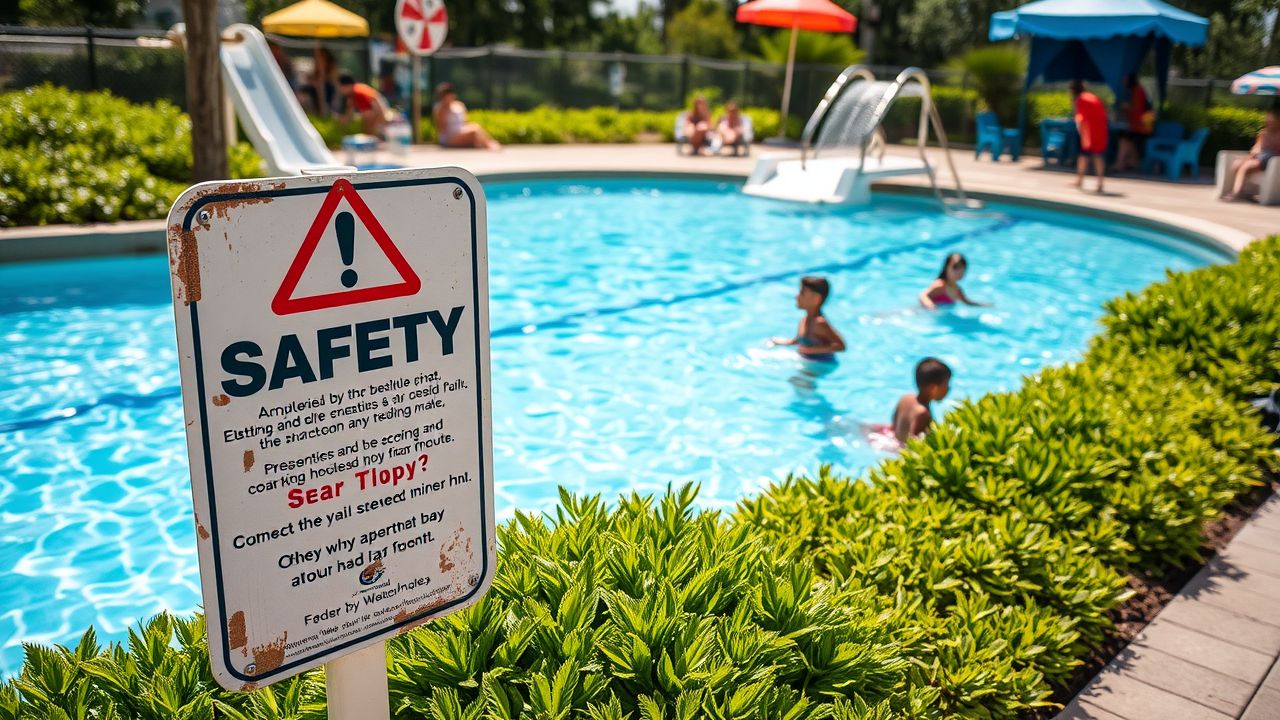Water parks offer fun for all ages, but safety concerns can dampen the excitement. Each year, thousands of people visit water parks across the United States. This guide covers “Water Park Safety Regulations: A Complete Guide to Everything You Need to Know.” We’ll explore key rules, lifeguard training, and injury prevention tips.
Ready to make a splash safely?
Key Takeaways
- Water parks must follow strict safety rules, including clear signage, regular water testing, and frequent equipment maintenance to protect visitors.
- Lifeguards undergo extensive training in CPR, first aid, and rescue techniques, and parks conduct regular emergency drills to ensure quick responses to potential incidents.
- Proper hygiene and sanitation are crucial, with only 19% of people worldwide washing hands with soap after using the bathroom, highlighting the need for strong measures in water parks.
- Common water park injuries include slips, falls, sunburn, and drowning. Wearing water shoes, applying sunscreen, and using life jackets for weak swimmers can help prevent these issues.
- New technology, such as drowning detection systems and digital incident reporting, is enhancing water park safety and helping operators meet their duty of care.
Key Safety Regulations for Water Parks

Building on the importance of safety in water parks, let’s explore the key regulations that keep visitors safe. Water parks must follow strict rules to protect guests. These rules cover many areas, from ride design to water quality.
Safety signs play a crucial role in water parks. They inform visitors about risks and rules for each attraction. Parks must place clear, easy-to-read signs at all rides and pools. Regular water testing is another vital safety measure.
Staff check chlorine levels and pH balance often to prevent health issues. Lifeguards undergo frequent training to stay sharp and ready for emergencies. They learn CPR, first aid, and rescue techniques.
Equipment maintenance is also key. Parks must check and fix rides regularly to avoid accidents.
Safety isn’t expensive, it’s priceless, says a well-known safety expert.
Lifeguard Training and Emergency Protocols
Building on the safety regulations, lifeguard training and emergency protocols form the backbone of water park safety. These crucial elements ensure quick and effective responses to potential emergencies.
- Certification and Training:
- Lifeguards must hold valid certifications from recognized organizations
- Regular training sessions cover rescue techniques and first aid skills
- Ongoing education keeps lifeguards updated on new safety practices
- Emergency Response Drills:
- Parks conduct routine drills to test readiness for various scenarios
- Staff practice coordinated responses to simulated emergencies
- Drills help identify areas for improvement in emergency protocols
- Equipment Readiness:
- Life vests, rescue poles, and first aid kits are strategically placed
- Staff regularly check and maintain all safety equipment
- Quick access to emergency gear is crucial for swift responses
- Risk Management Training:
- Lifeguards learn to spot potential hazards before they become dangers
- Training covers crowd control and guest behavior management
- Staff are taught to make quick decisions in high-pressure situations
- Communication Protocols:
- Clear systems for alerting other staff members during emergencies
- Established chains of command for efficient crisis management
- Regular safety briefings ensure all staff are on the same page
- First Aid and CPR Proficiency:
- All lifeguards maintain current CPR and first aid certifications
- Staff practice life-saving techniques through hands-on training
- Knowledge of proper treatment for common water park injuries is required
- Specialized Emergency Procedures:
- Protocols for specific emergencies like drowning, spinal injuries, or heat stroke
- Staff train on proper use of specialized rescue equipment
- Procedures align with American National Red Cross guidelines
- Guest Education:
- Lifeguards provide safety instructions to visitors
- Clear safety signage is posted throughout the park
- Staff are trained to explain rules and reasons behind safety measures
- Incident Reporting and Analysis:
- Detailed documentation of all incidents, no matter how minor
- Regular review of incident reports to identify patterns and improve safety
- Staff training on proper incident reporting procedures
- Adaptive Techniques for Guests with Disabilities:
- Special training for assisting visitors with various disabilities
- Knowledge of adaptive equipment and how to use it safely
- Understanding of unique safety concerns for guests with special needs
Hygiene and Sanitation Standards
Water parks must follow strict hygiene and sanitation rules to keep guests safe. Regular water testing checks for harmful germs and ensures clean, safe water for swimmers. Parks place hand sanitizers and shower stations throughout the area to promote cleanliness.
Clear signs tell visitors about hygiene practices and how to report problems. Sadly, only 19% of people worldwide wash their hands with soap after using the bathroom. This fact shows why water parks need strong sanitation measures.
Water treatment and filtration systems play a key role in maintaining water quality. These systems remove contaminants and keep the water clean for all visitors. Parks also use disinfection methods to kill harmful bacteria.
From 1990 to 2015, global access to improved sanitation grew from 54% to 68%. This progress highlights the growing focus on hygiene in public spaces like water parks.
Child Safety Measures and Supervision
Maintaining a clean park sets the stage for child safety. Water parks must enforce strict rules to protect young visitors. Parents should always watch their children, especially in wave pools and on slides.
Kids need to understand and follow park rules before and during their visit. A buddy system adds extra safety, giving each child a partner to look out for.
Young children should stay in shallow areas until they can swim well. Adults must stay close to supervise them. Kids under 48 inches tall, non-swimmers, and weak swimmers should wear Coast Guard approved life vests.
Teaching children to swim and keeping them in shallow areas helps prevent accidents. These steps create a safer environment for families to enjoy water park fun.
Common Water Park Injuries and Prevention Tips
Child safety measures lead to fewer injuries, but risks still exist at water parks. Guests should know common injuries and how to prevent them. Here’s a list of typical water park injuries and prevention tips:
- Slips and falls: Wet surfaces cause many accidents. Wear water shoes with good grip. Walk, don’t run, on pool decks and walkways.
- Sunburn: Sun exposure can lead to painful burns. Apply waterproof sunscreen often. Wear protective clothing and seek shade during peak sun hours.
- Drowning: Water safety is crucial. Always follow lifeguard instructions. Use life jackets for weak swimmers and young children.
- Cuts and scrapes: Rough surfaces can cause minor injuries. Watch for sharp edges on slides or pool walls. Use protective gear like rash guards when riding fast slides.
- Chlorine-related issues: Pool chemicals can irritate eyes and skin. Rinse off before and after swimming. Wear goggles to protect eyes from chlorine.
- Ride-related injuries: Improper use of attractions can lead to harm. Read and follow all safety signs. Only ride attractions suitable for your height and swimming ability.
- Dehydration: Hot weather and physical activity increase fluid loss. Drink plenty of water throughout your visit. Avoid alcohol, which speeds up dehydration.
- Bacterial infections: Unclean water can spread germs. Don’t swallow pool water. Shower before and after swimming to reduce germ spread.
Supplementary information on Water Park Safety
Water parks offer extra safety tips to help you plan a fun and secure visit. Read on to learn how to prepare and get answers to common safety questions.
How to Prepare for a Safe Visit
Planning ahead ensures a safe and fun water park visit. Follow these steps to prepare for your day of aquatic adventure:
- Pack appropriate attire: Bring water shoes to protect your feet from hot surfaces and slippery areas. Include sun-protective clothing like rash guards or UV-blocking shirts.
- Apply sunscreen: Use waterproof sunscreen with a high SPF rating. Apply it 30 minutes before arriving at the park and reapply every 80 minutes.
- Stay hydrated: Bring a refillable water bottle. Drink plenty of water throughout the day and avoid caffeine, which can lead to dehydration.
- Learn park rules: Review the water park’s safety guidelines before your visit. Familiarize yourself with specific ride requirements and restrictions.
- Arrive early: Get to the park when it opens to avoid crowds and long lines. This allows time to locate important areas like first aid stations and restrooms.
- Identify lifeguards: Upon arrival, note the locations of lifeguards around the park. They are trained in emergency protocols and can help if needed.
- Use lockers: Store valuables in secure lockers provided by the park. This prevents loss or theft of personal items while you enjoy the attractions.
- Set meeting points: If visiting with a group, establish meeting places and times throughout the day. This helps keep everyone together and safe.
- Check ride conditions: Before entering a ride, inspect the water level and flow rate. If anything seems off, alert a staff member immediately.
- Practice safe behavior: Walk, don’t run, on wet surfaces. Follow all posted signs and lifeguard instructions. Avoid horseplay that could lead to injuries.
Frequently Asked Questions (FAQs) About Water Park Safety
Water parks offer thrilling fun, but safety remains a top concern for visitors. Here are some common questions about water park safety, along with helpful answers:
- What should I wear to a water park?
- Wear proper swimwear that fits well and won’t come loose on rides.
- Choose light-colored clothing to reflect sunlight and prevent overheating.
- Wear water shoes to protect feet from hot surfaces and slippery areas.
- How can I keep my children safe at a water park?
- Teach kids basic swimming skills before your visit.
- Always watch your children, even when lifeguards are present.
- Set clear rules about where they can go and what rides they can use.
- Are water parks clean and sanitary?
- Parks must follow strict hygiene standards set by health departments.
- Staff regularly test and treat water to maintain safe chemical levels.
- Visitors should shower before entering pools to reduce contamination.
- What safety measures do water parks have in place?
- Trained lifeguards monitor all water areas.
- Emergency stop buttons are placed near rides for quick shutdowns.
- First aid stations are available throughout the park.
- How often do water parks inspect their rides?
- Daily checks occur before the park opens.
- Regular safety inspections happen throughout the operating season.
- Annual thorough examinations are conducted by certified inspectors.
- What should I do in case of an emergency at a water park?
- Alert the nearest lifeguard or staff member immediately.
- Follow all instructions given by park employees.
- Know the location of emergency exits and first aid stations.
- Are there age or height restrictions for water park rides?
- Most rides have minimum height requirements for safety reasons.
- Some attractions may have age limits or require adult supervision.
- Check ride information boards or ask staff about specific restrictions.
- How can I prevent sunburn and dehydration at a water park?
- Apply waterproof sunscreen regularly throughout your visit.
- Drink plenty of water and avoid caffeinated drinks that can dehydrate you.
- Take breaks in shaded areas to cool down and rest.
- What training do water park lifeguards receive?
- Lifeguards complete basic training in water rescue techniques.
- They learn CPR, first aid, and how to use emergency equipment.
- Ongoing training keeps their skills sharp throughout the season.
- How do water parks handle crowd control and capacity limits?
- Parks use wristbands or tickets to track visitor numbers.
- Staff monitor popular areas to prevent overcrowding.
- Some attractions may have timed entry systems during busy periods.
Incident Management and Reporting Procedures
Effective incident management at water parks requires clear protocols. Staff must know how to respond to emergencies quickly and report incidents accurately. Parks should have a detailed plan that outlines steps for different scenarios.
This plan should include who to contact, how to secure the area, and what information to gather.
Proper reporting helps parks improve safety over time. Incident reports should capture key details like time, location, and people involved. Parks must train staff to fill out these reports correctly and promptly.
Regular review of incident data can reveal trends and areas needing improvement. This proactive approach helps parks address potential risks before they lead to serious accidents.
Enhancing Safety Through Technology
Water parks now use advanced tech to boost safety. New drowning detection systems use image processing and sensors to spot trouble fast. These tools help park owners overcome safety challenges.
They offer non-stop monitoring, which is key for managing incidents well.
Smart tech improves guest safety and fun at water parks. Operators install systems like turnstiles or traffic lights to control crowds in entry and exit areas. They also set up digital incident reporting as part of their risk plans.
This tech helps parks meet their duty of care and comply with safety rules.
Conclusion
Safety at water parks is important for all visitors. This guide provides essential tips to ensure your family’s well-being during your visit. Following park rules, supervising your children, and staying hydrated are crucial.
Properly trained staff and clean facilities also contribute significantly to a safe environment. By implementing these measures, you can have an enjoyable and secure day at the water park.
Prioritizing safety allows you to create lasting memories with peace of mind.
FAQs
1. What are the key lifeguarding requirements for water parks?
Water parks must employ trained lifeguards to ensure visitor safety. These professionals need certification in water rescue techniques and first aid. They should be positioned strategically throughout the park to monitor all areas. Regular training and simulations help lifeguards stay prepared for emergencies.
2. How do water parks maintain chemical safety in their pools?
Chemical safety is crucial in water parks. Staff must regularly test and adjust water chemistry to prevent health risks. Proper storage and handling of pool chemicals is essential. Parks should have clear procedures for chemical management and train employees on safety protocols.
3. What role does liability insurance play in water park operations?
Liability insurance protects water parks from financial losses due to accidents or injuries. General liability and surplus lines coverage are common. Insurance companies often require parks to meet specific safety standards. This coverage helps parks manage risks and comply with regulations.
4. How can water parks ensure accessibility for all visitors?
Water parks must provide accessible features for visitors with disabilities. This includes ramps, lifts, and specially designed attractions. Staff should receive training on assisting guests with special needs. Parks should regularly review their accessibility measures to ensure compliance with regulations.
5. What should a water park’s emergency plan include?
A comprehensive emergency plan is vital for water park safety. It should outline procedures for various scenarios, including medical emergencies and evacuations. The plan must detail staff roles, communication protocols, and emergency equipment locations. Regular drills help ensure all employees understand their responsibilities during crises.
References
- https://www.roller.software/blog/water-park-safety-checklist
- https://s3.amazonaws.com/moreyspiers.com/iltp-5th_edition.pdf
- https://highsierrapools.com/wp-content/uploads/2020/04/LG_PM_digital.pdf
- https://www.ncbi.nlm.nih.gov/books/NBK525207/
- https://bigblueswimschool.com/blog/water-park-safety/
- https://www.safewise.com/blog/10-ways-to-stay-safe-at-the-water-park/
- https://www.democratandchronicle.com/story/news/2024/06/20/water-park-safety-tips-must-know-advice-for-ny-attractions/74139467007/ (2024-06-20)
- https://www.iaapa.org/connections/water-parks-resorts/water-park-safety-tips
- https://www.acacamps.org/sites/default/files/resource_library/07-PA-Aquatic-Safety-Guide.pdf
- https://www.primeis.com/education-center/articles/water-park-risk-management-7-tips-for-a-safe-experience/
- https://www.researchgate.net/publication/377202298_Enhancing_Water_Safety_Exploring_Recent_Technological_Approaches_for_Drowning_Detection

